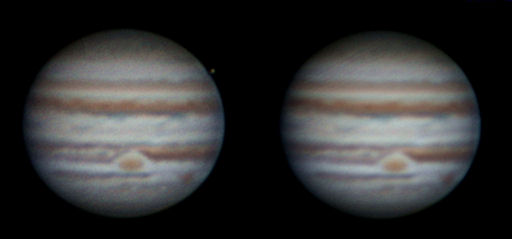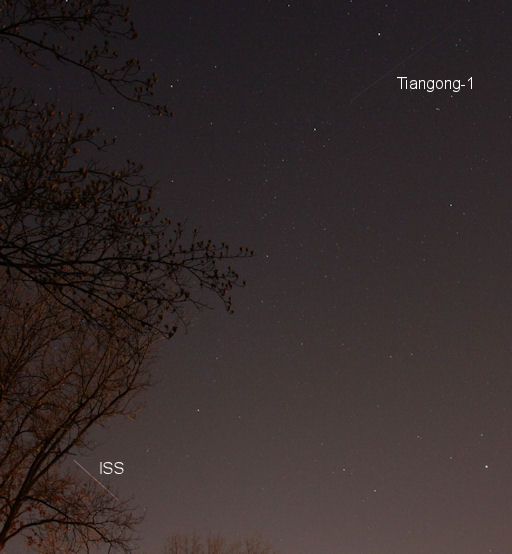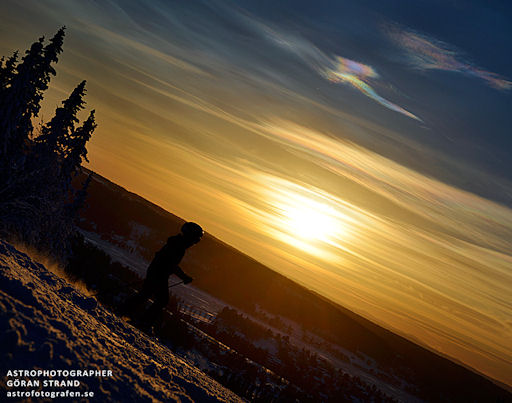Metallic photos of the sun by renowned photographer Greg Piepol bring together the best of art and science. Buy one or a whole set. They make a stellar gift. | | |
LAST AURORAS OF 2012? A medium-speed (~450 km/s) stream of solar wind is buffeting Earth's magnetic field on Dec. 31st. This could spark geomagnetic disturbances around the poles. Arctic sky watchers should be alert for the last auroras of 2012. Auroras alerts: text, voice.
3D JUPITER: This just in: Jupiter is a sphere. You can prove it to yourself by staring at the stereo pair below and crossing your eyes. The third image that appears in the middle shows the shape of the giant planet in three dimensions.

French photographer Sylvain Weiller took the pictures using a 12-inch telescope on December 30th. Jupiter's rapid rotation provided the two points of view necessary for stereo imaging. "The two pictures are separated by about 10 minutes," explains Weiller. "I processed them using SPM (Stereophoto Maker) to make the 3D-couple." More details are given here.
"The moon in the image is Europa," he adds. "I caught it just a couple of minutes from being eclipsed behind the planet." (PS: Europa looks spherical, too.)
Realtime Jupiter Photo Gallery
DOUBLE SPACE STATION FLYBY: In a short span of 13 seconds on Dec. 29th, amateur astronomer Val Germann watched two space stations fly over his backyard in Columbia, Missouri. The ISS and China's Tiangong-1 space station were almost simultaneously visible to the naked eye:

"I have been waiting for a chance at this combination for some time, finally getting an image this evening," says Germann.
Most readers are familiar with the 450-ton ISS. Fewer, perhaps, know about the 8.5-ton Tiangong-1 (Heavenly Palace-1), China's first space station. It was launched in Sept. 2011 and briefly boarded by taikonauts (Chinese astronauts) in June 2012. The crew included the first Chinese female astronaut, fighter pilot Liu Yang, 33. Another group of taikonauts is scheduled to visit in June 2013 as the Chinese space program continues to practice rendevous and docking procedures. According to some reports, the Tiangong-1 will be de-orbited in late 2013 to make way for more advanced experimental stations, Tiangong-2 and Tiangong-3, in 2014 and 2015. Ultimately, China hopes to place an Mir-class station in orbit by 2020.
See the Tiangong-1 before it goes! Spaceweather's Simple Flybys app turns your smartphone into a field-tested space station tracker. It works for both the ISS and the Tiangong-1.
Realtime Space Weather Photo Gallery
NACREOUS CLOUDS: Arctic sky watchers should be alert for bright splashes of color this weekend: The nacreous clouds are back. Göran Strand of Östersund, Sweden, photographed this specimen on Dec. 28th:

"The sky was dotted with small but intense nacreous clouds," says Strand. "They lasted for a couple of hours and changed form very often." A close-up photo highlights the vivid colors that are the signature of these clouds.
Atmospheric optics expert Les Cowley comments: "Of all Earth's clouds, nacreous clouds are the most spectacular, and a very rare treat for skywatchers. For up to an hour after sunset or before dawn they glow like eerie electric discharges or gas jets in the darkening sky, their filmy shapes slowly curling and uncurling with intense shifting colors. They are composed of tiny ice crystals more than twice as high as ordinary clouds, 9-16 miles up, in the stratosphere and form at temperatures of minus 85 Celsius and below. The crystals are all of similar size and they diffract the high altitude sunlight to make the colours."
"Search for nacreous clouds at high latitudes (e.g., Scotland, Scandinavia, Iceland, Northern US) in winter and preferably downwind of mountains," Cowley advises. "They like stormy weather that perhaps creates gravity waves to loft the necessary moisture to make them upwards across the tropopause into the stratosphere. Once seen they are never forgotten!"
Realtime Nacreous Cloud Photo Gallery
Realtime Aurora Photo Gallery
Realtime Noctilucent Cloud Photo Gallery
[previous years: 2003, 2004, 2005, 2006, 2007, 2008, 2009, 2011]

